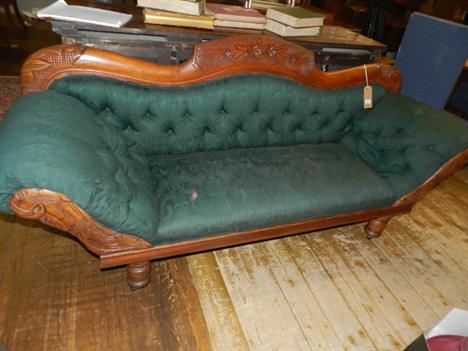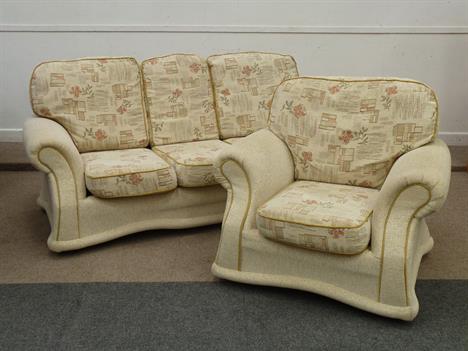We found 58283 price guide item(s) matching your search
There are 58283 lots that match your search criteria. Subscribe now to get instant access to the full price guide service.
Click here to subscribe- List
- Grid
-
58283 item(s)/page
A Set of Six American Classical Carved Mahogany Side Chairs, early 19th c., attributed to the workshop of Duncan Phyfe, each with baluster-turned crest rail, scrolled stiles, pierced slat with lyres centering gilt-brass rosette, slip seat, saber legs with hairy shanks terminating in paw feet. Note: Duncan Phyfe is known to have produced chairs and sofas decorated with a single, small gilt-brass mount, including a sofa made (1810-1815) for New York merchant Thomas Cornell Pearsall and a side chair with a history of Philadelphia ownership, dated 1815-1820. Each stands on a curule base applied in the center with a gilt-brass lion`s mask. The paw feet, hairy shanks, and round bosses with multiple rings on the chairs offered here are details found on chairs documented or attributed to Phyfe. A Phyfe side chair bearing these features, as well as a pierced slat centering a carved rosette, is in the collections of the New York State Museum in Albany, NY. References: Kenny, Peter M. and Michael K. Brown. Duncan Phyfe: Master Cabinetmaker in New York, 2011, pp. 178-181, plate 15 and pp. 188-191, plate 21; Scherer, John L. New York Furniture at the New York State Museum, 1984, p. 41, fig. 38.
A pair of George III giltwood armchairs by Thomas Chippendale, the arched back with palmette carved crest rail, the rosette and bead carved frames with ebonised detail and with associated 18th century French floral tapestry, the shaped arms terminating in stylised palmettes, above shaped and moulded down-swept arm supports with anthemion and Greek key, with bead moulded rails, raised on reeded tapering legs, terminating with stiff leaf carved feet. (2) Chippendale supplied furniture to Worsley at Appuldurcombe between 1776-1778. The above lot is part of a suite of giltwood furniture supplied for the drawing room at Appuldurcombe. The room was hung with '8 pieces of Gobelin Tapestry, representing the Arts & Sciences, copied from Boucher's paintings at Versailles.' They were inventoried about 1779 as: '8 Cabriole elbow chairs carv'd & gilt in burnish'd gold & cover'd with Gobelin Tapestry. A Sofa to match, cover'd wt. Do.' (see L. Boynton, "Sir Richard Worsley's Furniture at Appuldurcumbe Park", Furniture History, 1965, pp.39-58). Design motifs present on the above correspond with furniture supplied to Appuldurcombe such as a pier table illustrated in C. Gilbert, "The Life and Work of Thomas Chippendale", fig 499, p. 273. These include beaded frames, anthemion and rosette carved details and reeded tapering legs, with stiff leaf carved feet. The anthemion and stiff leaf carved feet details are also present on the mahogany dining chairs supplied to Appuldurcombe, as illustrated in fig. 152 p. 94. The Greek key details on the profile of the arm supports are present on a library chair supplied by Chippendale to Brocket Hall fig. 151, p. 93. A family connection can be established between Appuldurcombe and one of Chippendale's more important commissions for Edwin Lascelles at Harewood House. Edwin Lascelles' step daughter married Sir Richard Worsley giving rise to the assertion that the Appuldurcombe interior could have been influenced by the emerging Neo Classical remodelling of the interiors of Harewood House by Chippendale. ref. C. Gilbert, "The Life and Work of Thomas Chippendale", W. S. Knoecky Associated, Inc., 1978. Supplied to Sir Richard Worsley, b. 1751- 1805, 7th Baronet of Appuldurcombe, Isle of Wight. He was a member of parliament for Newport 1774-1784 and re-elected as Member of Parliament for Newtown 1796-1801. Comptroller of the Household 1779-1782. The last British Minister Resident to the republic of Venice 1793-1797, after which this diplomatic posting was demolished. Governor of the Isle of Wight 1780-1782. Vice Admiral of the Isle of Wight 1780-1791. CONDITION REPORT: The black painted ebonised detail is believed to have been applied at a date later than that of construction. The tapestry back panels are in reasonably intact condition but the seats are very worn in the area of design of the flower baskets and along the front edge of the seat, the armpads too have wear. Almost every section of the frames has flaking gilding, the legs in particular have many losses. On one chair the arm has become detached where it joins the back but is complete The carved detail to the frames such as beadwork, paterae and honeysuckle motifs all have wear rubbing which is particularly evident on the beading to the top rails with most gilding and size rubbed away. The underside of the frames have an added oak strengthening rail to the back rail of the seat which may perhaps have been added when the seats were sprung , with webbing having been added to hold the springs in place.
-
58283 item(s)/page



























































